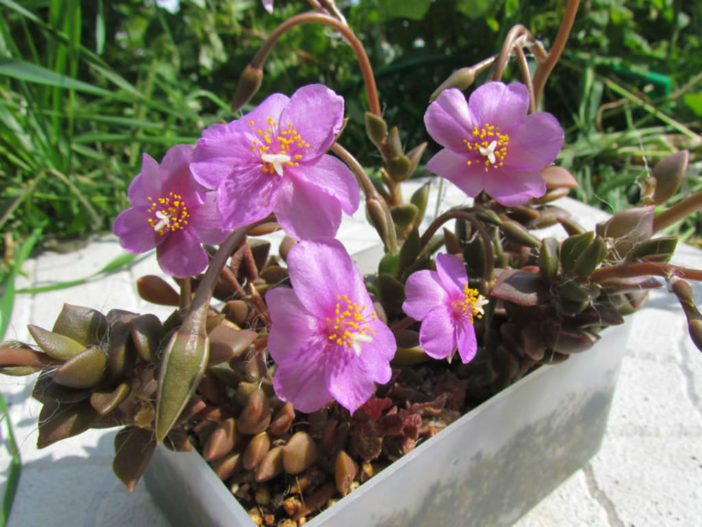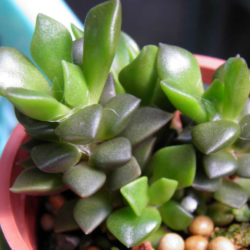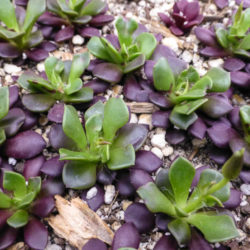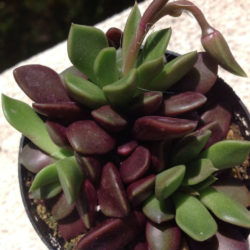Scientific Name
Anacampseros rufescens (Haw.) Sweet
Common Name(s)
Sand Rose
Synonym(s)
Portulaca rufescens, Ruelingia rufescens
Scientific Classification
Family: Anacampserotaceae
Genus: Anacampseros
Description
Anacampseros rufescens is a small succulent with erect or slowly creeping, dichotomously branched stems and fleshy leaves spirally arranged along the stem. It can grow up to 3.2 inches (8 cm) tall and spread outwards, forming a low clump and developing a thick caudex-like base. The leaves are ovate with pointed tips and can reach 0.8 inches (2 cm) in length and 0.4 inches (1 cm) in width. In shaded positions, the upper surface of the leaves is olive green, while when exposed to full sun, they become reddish-brown to purple. The lower surface of the leaves is reddish to deep purple. The white hairs between the leaves help the plant survive droughts by trapping water vapor from the air.
The flowers range from pink to rose-purple and appear on stalks up to 4 inches (10 cm) long in late spring and summer. They open briefly in the afternoon only on sunny days and close by nightfall.
Origin
Anacampseros rufescens is native to South Africa. It grows on rocky slopes, exposed short scrub, and barren or sparsely vegetated flats in gravelly soil or among rocks in the Eastern Cape, Free State, and KwaZulu-Natal provinces.

Hardiness
USDA hardiness zones 9a to 11b: from 20 °F (−6.7 °C) to 50 °F (+10 °C).
How to Grow and Care
Anacampseros grow well in partial sun with bright light enhancing the leaf colors and keeping them compact. They require gritty, free-draining soil with added organic material and low to moderate watering. The beautiful caudiciform species are prone to rot and should be sparingly watered. Feed with a high potassium fertilizer during the growing season diluted to 1/4 potency and mixed into the watering can for application. Anacampseros is an excellent plant for container growing. It always looks good and stays small. It looks fine in a cold greenhouse and frame. It does well outdoors in raised beds and terraces as well.
These succulents may be attractive to various insects. Still, plants in good condition should be nearly pest-free, particularly if grown in a mineral potting mix with good exposure and ventilation. Nonetheless, watch carefully for any significant decline in health. This may signal a pest problem that should be dealt with quickly to prevent scarring, stunting, and even death.
See more at How to Grow and Care for Anacampseros.
Links
- Back to genus Anacampseros
- Succupedia: Browse succulents by Scientific Name, Common Name, Genus, Family, USDA Hardiness Zone, Origin, or cacti by Genus
Photo Gallery
Click on a photo to see a larger version.


